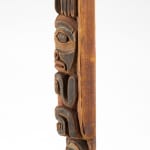-
Artworks
UNIDENTIFIED ARTIST, Tlingit
Hollow Back Model Totem, late 19th centurypolychrome and wood, 18 x 4.25 x 3.5 in (45.7 x 10.8 x 8.9 cm)
unsigned.
LOT 39
ESTIMATE: $3,500 — $5,000
PRICE REALIZED: $6,600.00Further images
This model pole is unusual for its shallow relief-carved style. The depth to which the figures are carved leaves the figures comparatively flat, with no protruding beaks or noses, etc....This model pole is unusual for its shallow relief-carved style. The depth to which the figures are carved leaves the figures comparatively flat, with no protruding beaks or noses, etc. Nonetheless the figures are expressive, and they wrap around the curve of the pole to nearly half the diameter. This gives the pole some heft and a feeling of strength.
The three figures from the top are a raven or crane, a human image, and at the bottom an uncertain image with some references to a shark or dogfish. This figure lacks the usual high dome of the shark/dogfish forehead, instead showing a short forehead embellished with two short U-shapes above the eyebrows. Shark/dogfish iconography appears in the steep arch of the mouth and the three gill slits between red features on each cheek. The final identity is most likely a shark or dogfish, despite the unusual representation.
The figures are carved in a late nineteenth century Tlingit style, referring to both the sculpture and flat design. Sculptural traditions have often survived more intact than two-dimensional styles, and this is reflected in this pole. The faces show a fair degree of adherence to Tlingit-style face sculpture of the historic period, while the designs on the wings less accurately represent the established formline tradition.
The back of the pole is a half cylinder in cross section, and the bottom figure is set back from the outer level of the two upper figures. This unusual feature is impossible to explain with certainty and is not ordinarily present in the totem pole tradition, in either models or full-size. Perhaps the bottom figure necessitated a change from the original plan, moving the surface back to accommodate the carving of a different image in that position on the pole. Or perhaps the change in level has symbolic significance, separating the shark/dogfish from the worlds of the bird and human.
Steven C. Brown
Provenance
The Innuit Gallery, Toronto;
Acquired from the above by the present Private Collection, Toronto, 1999.
Join our mailing list
* denotes required fields
We will process the personal data you have supplied in accordance with our privacy policy (available on request). You can unsubscribe or change your preferences at any time by clicking the link in our emails.






